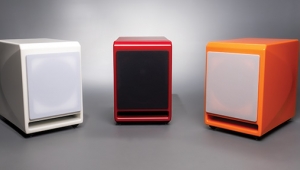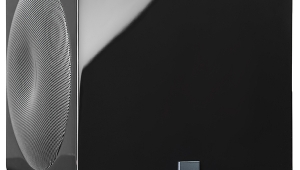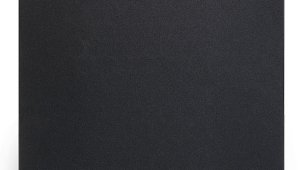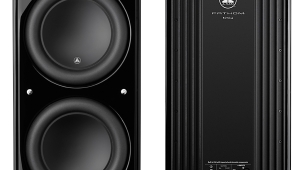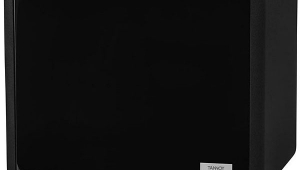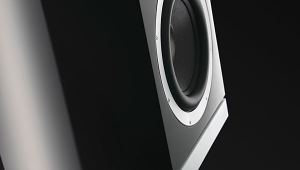| Columns Retired Columns & Blogs |
Revel Ultima Sub 30 powered subwoofer
It didn't seem like such a big deal. After all, when designer Kevin Voecks added a passive radiator to the bottom of Revel Loudspeakers' powerful Ultima Sub 15 subwoofer, no one expected that the resulting 6dB increase in bass output below 35Hz would be so audible. However, Revel's sophisticated double-blind listening tests (described in my review of their flagship Ultima Salon full-range loudspeaker in the March 1999 Stereophile, revealed that a big change had occurred. With now twice the radiating surface, the modified Sub 15 produced significantly deeper, more powerful bass.
 This should have been no surprise—Voecks' previous speaker designs had excelled in their bass response. His 5'-tall bass-reflex subwoofer for the Snell Acoustics Reference A loudspeakers, and the triple woofers of his Revel Ultima Salon, both produced clean bass down to 20Hz and below. So when Andrew Clark, VP of Marketing of the Harman Specialty Group, offered me the opportunity to review Revel's new Ultima Sub 30, I leapt at the chance.
This should have been no surprise—Voecks' previous speaker designs had excelled in their bass response. His 5'-tall bass-reflex subwoofer for the Snell Acoustics Reference A loudspeakers, and the triple woofers of his Revel Ultima Salon, both produced clean bass down to 20Hz and below. So when Andrew Clark, VP of Marketing of the Harman Specialty Group, offered me the opportunity to review Revel's new Ultima Sub 30, I leapt at the chance.
Inside the box
The Ultima Sub 30 ($5990) is a powered subwoofer with an active 15" driver firing forward and a passive 15" radiator facing downward, both sharing the same inner enclosure. Kevin Voecks explained that the passive radiator acts like a port, but without any of a reflex port's chuffing noise. The 15" woofer uses a 4.7kg magnet, two copper voice-coils, and two spiders. The driver has one of the longest peak-peak excursions I've encountered in a subwoofer: 3". The true linear volume displacement is 275 cubic inches. Both drivers are set into a slightly flared cabinet wider at the front than at the rear, close to 2' on a side, and weighing 145 lbs.
All crossover filter and equalizer settings, as well as system connections, are made on the rear service panel. The internal amplifier—1000W RMS class-AB with a switching power supply—and the crossover circuitry are mounted on the inside of this thick metal panel. Three pairs of balanced XLR connectors, paralleled by six line-level RCA jacks, include: a stereo input pair, an output pair, and a "through" signal pair for a second daisy-chained subwoofer.
The panel's top row of controls operate three separate parametric equalizers. These modify the frequency response at three points, adjustable from 18 to 80Hz across a bandwidth of 0.1-1.0 octave, with level boost up to +6dB or level cut to -14dB.
The middle of the Sub 30's service panel features, from left to right, a three-position Contour switch, and sets of low-pass and high-pass controls. The low-pass filter is defeatable, and the filter's slopes can be set to 24 or 48dB/octave. The center frequency of the low-pass filter can be adjusted from 30 to 80Hz, and the phase of the subwoofer signal can be adjusted from 0$d to 180$d from the signal going to the main speakers.
The Sub 30's nondefeatable high-pass filter modifies the signal to the amplifier driving the main speakers, removing bass frequencies with either a 12 or 24dB/octave rolloff. The crossover point can be set to 30-80Hz in 10Hz increments. Because the high-pass filter is always on, I found it impossible to evaluate the full-range output of the main speakers (Sub 30 switched off) unless I bypassed the subwoofer.
At the bottom of the panel is a switch toggling between Auto Turn-On and 12V Trigger, Power On/Off switch, AC voltage selector, and fused power connector for the detachable IEC power cord. When the Power On mode is set to 12V Trigger, a steady 12V DC voltage applied to the trigger power terminals will turn the Sub 30 on. When the Contour switch is set to external trigger, a steady 12V voltage applied to the trigger music/film terminals will automatically select the Film contour response.
The Sub 30's curved rosewood side panels and bowed grille are consistent with the styling of Revel's flagship full-range speaker, the Salon. The internally braced, cabinet is made of 1"-thick MDF, with the positions of the braces chosen with the help of laser interferometry. The Sub 30 sits on four huge, adjustable spiked feet, supplied with rubber covers to prevent the massive enclosure from damaging wood floors. Locking rings can be set to adjust the length of the feet so that there can be at least ¼" clearance between the edge of the subwoofer's side panels and the floor.
The Ultima Sub 30's fit'n'finish are tops, easily matching the company's flagship Salon. The rosewood side panels had a luster and sheen that were extraordinary. Hardware and connections are sturdy, gold-plated, easily accessible, and look as if they'll last a lifetime.
Setup
I unpacked and shoved the Ultima Sub 30 across the living room to a corner to the right of my Quad ESL-989 speakers. I turned the subwoofer over, loosened the locking rings around the four feet, and adjusted their height until the subwoofer side panels cleared the floor by 1/4". The Quads were positioned 5' from the rear wall, 3' from the side walls, 8' apart, and slightly toed-in. My listening chair faced the short wall of my lightly damped, rectangular, 4056-cubic-foot listening room (26' long by 13' wide by 12' high). Behind the listening chair, the other end of the room opens into a 25' by 15' by 8' kitchen.
Next, I connected the Sub 30 to my system, using the "Stereo Power Amplifier and a Revel Sub 30 with Crossover" setup shown in fig.10 of the Sub 30's owner's manual (p.19). I ran a main pair of stereo interconnects to the sub's line-level right and left inputs, set the high-pass filter to 80Hz and 12dB/octave, the low-pass filter to 80Hz and 48dB/octave, the Contour switch to Music, and ran interconnects from the Sub 30's right and left RCA out jacks to my Levinson ML-2 power amps. Kevin Voecks suggested that the high- and low-pass filter frequencies could be set to 80Hz, but that the filter slopes worked best when set to different values. At that point, I switched the EQ All switch to Out, which bypasses the Sub 30's three equalizers.
- Log in or register to post comments
